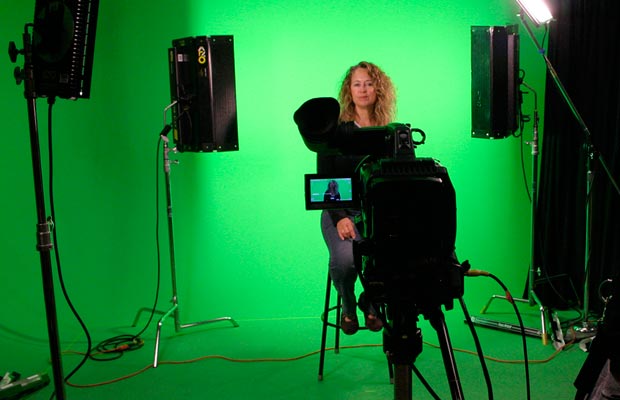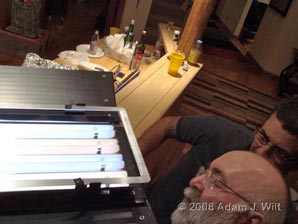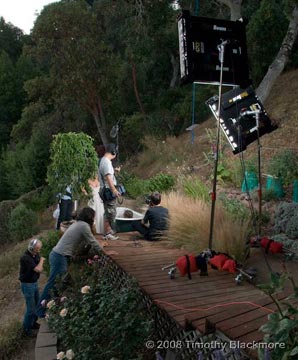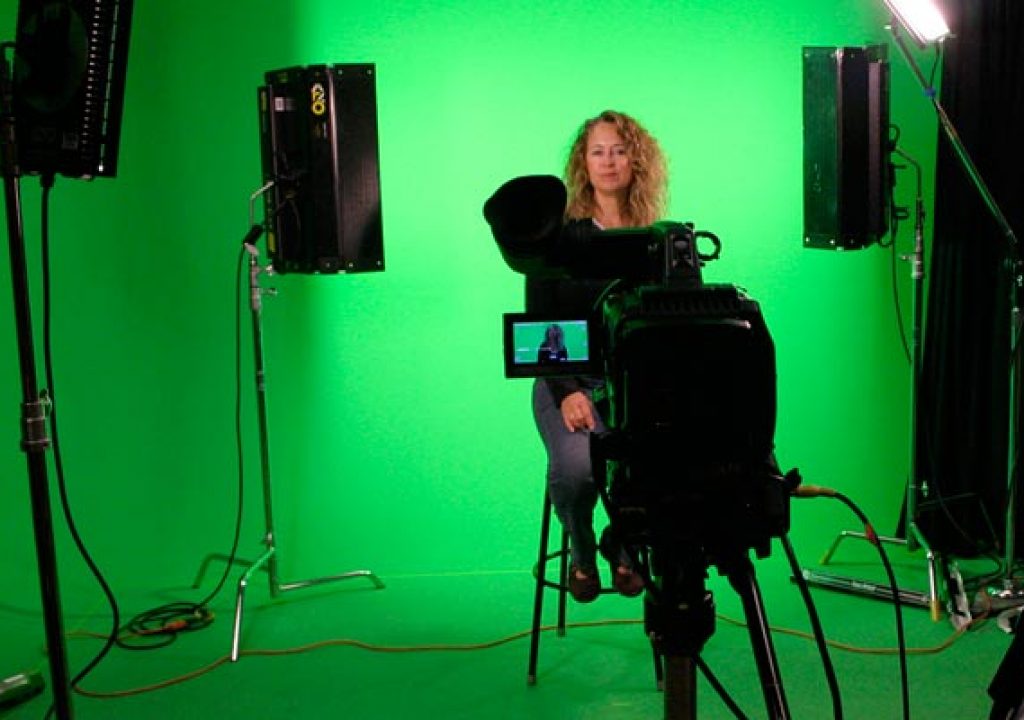
It started as a simple-enough email question from writer Kevin P. McAuliffe to the rest of the PVC crew:
I’m looking for a good, low cost basic lighting kit. 3 lights (Key, Fill and Back), stands, etc. I have no idea who would be considered “good”, as “For God sakes Jim, I’m an editor, not a lighting director!”
What followed was a flood of very useful advice on lighting equipment – as well as its applications, from outdoor shots to greenscreen. Rather than keep the replies private, we decided to share the wealth with our PVC readers. (Note: We’ve added replies from Steve Hullfish, Alex Lindsay, and Art Adams since this article was first posted.)
Jeff Foster: Depends on your budget and what your definition of “good” and “low cost” are. Also what your needs are, as that is a very broad range you’re aiming for there! You can go anywhere from a $300 mini hot light kit you may find online to several thousand for Kino Flos or Lite Panels.
Personally, I would go with Kino Flo BarFlys (Two 200s and One 100) and some portable stands. If you need a large softbox then that’s a different story. It really all depends on what you’re trying to shoot, how portable it needs to be and what kind of lighting effects you’re trying to achieve.
And if you’re going to shoot Green Screen then we’ll have to talk! 😉
Bruce Johnson:: I like my LTM Pepper kit. I added a Chimera Video Small for the 650.
There is a good reason I call the Chimera “Sex In A Tube.” Used properly, this thing would make Quasimodo look like Fabio. (I bought an eggcrate for it, too.)
I like having fresnel lights instead of open-faced like Lowels and such – they are so much more controllable. Now I need a small, powerful ellipsoidal to fill it out.
Of course, if you are flying, this thing weighs a ton. I used to repack the bulk of the kit into a hard-sided golf tube, but on one trip my 300-watt light got broken – the case casting got cracked, but it still works. If I wasn’t so cheap, that wouldn’t have happened.
 Adam Wilt: I’m with Jeff; I really like Kinos as all-purpose lights, because you can relamp them for 2900K, 3200K, and 5600K (or a mix thereof) as needed, and they’re sparing on power and cool to work around. The Barflys are nice, but I’d make one or two of the lights Diva 400s, both for the ability to use ’em as large, soft sources and for the added light output when trying to fill in bright ambient keys like naturally-lit windows.
Adam Wilt: I’m with Jeff; I really like Kinos as all-purpose lights, because you can relamp them for 2900K, 3200K, and 5600K (or a mix thereof) as needed, and they’re sparing on power and cool to work around. The Barflys are nice, but I’d make one or two of the lights Diva 400s, both for the ability to use ’em as large, soft sources and for the added light output when trying to fill in bright ambient keys like naturally-lit windows.
Of course you don’t really have any hard sources with Kinos (and there’s that whole “low-cost” business, too). If you’re OK with incandescents, have a look at the various kits from Lowel. Totas for area coverage and softboxes or umbrellas, DPs and/or Omnis for focused sources.
(Lowel also has fluoros, both straight-tube arrays and CF softboxes, but I don’t know how color-accurate their lamps are.)
Lowel kits are a lot more expensive than Smith-Victor or other low-end lights (or the perennial DIY favorite, shop lights from Home Depot!) but they’re a lot more affordable than an Arri or Mole-Richardson kit. You get what you pay for: Lowels aren’t as cast-iron durable or as precisely controllable as the pricey stuff, but they won’t constantly frustrate you like the cheap stuff will. (FWIW the two Totas I bought in 1979 are still going strong.)
Matthew Jeppsen: Kinos on a budget = Cool Lights.
Jeff Foster: I like the Diva 400s too but they’re a lot bigger and not as portable as the BarFlys, though two of them will light a portable green screen evenly. They’re made pretty cheap though – I’ve had a couple literally fall apart on me. The BarFlys are more rugged for a lot of transport and use. What you’re paying for with Kino Flos is the ballast. You can get cheaper lights and use Kino tubes in them as well, but if your voltage is off with the ballasts then so might your color temp be. (Usually nothing your white balance can’t take care of in most cases.)
I’ve used compact fluorescent bulbs in some homemade lights I’ve built that are fairly cheap to make/use but you still have to spend some $ on good quality color-correct bulbs. I stay away from the Home Depot shop lights as the ballasts are usually way too noisy – especially in a small studio.
Again – it really depends on your budget and what you’re shooting and how often. You may be better off to just rent lights as needed if you rarely need them.
Adam Wilt (replying in-line to a private email from Bruce Johnson):
I’m with Jeff; I really like Kinos as all-purpose lights, because you can relamp them for 2900K, 3200K, and 5600K (or a mix thereof) as needed, and they’re sparing on power and cool to work around.
But: You have to have a selection of fragile tubes and, as you point out, there are no hard-light choices. Wanna turn a tungsten into a daylight? Slap on a blue gel – almost any will do, and the are lightweight and cheap. Want it soft? Chimera, baby – there is no substitute.
I am totally down with Chimeras, I use ’em on my Totas all the time.
The problem with gelling tungsten for daylight is the two-stop light loss in doing so. And if I’m lighting for daylight, I usually need all the light output I can get. Now I need 4000 watts to light what 1000 watts would work for at 3200K. On location, unless I have an electrician with me to do tie-ins, I can’t get ahold of that sort of power.
 OTOH I did area fill under trees, outside in the bright sun, with two Kino VistaBeam 600s. It would have taken about 6kW to do that with tungsten, even before gelling for daylight… And both instruments were plugged into a single household circuit. THAT’s why I like Kinos!
OTOH I did area fill under trees, outside in the bright sun, with two Kino VistaBeam 600s. It would have taken about 6kW to do that with tungsten, even before gelling for daylight… And both instruments were plugged into a single household circuit. THAT’s why I like Kinos!
The open-faced Lowels are a pain to use (even with barndoors and blackwrap they still spill all over the place,) and when they break (sharing kits with other shooters, they break A LOT) they are a nightmare to fix.
Don’t get me wrong – back in the days of the Lowel D they were bulletproof, but in the intervening 2 decades they have gotten much more gimmicky, and use lighter-weight components (have you burned a reflector bowl out of your Omni light yet? Don’t worry, you will.)
Perfectly valid points. Like I said, you get what you pay for. I don’t share my kit with other gorillas shooters – so my lights don’t suffer the abuses of careless, I-don’t-own-this-so-to-heck-with-it folks.
I haven’t bought any Lowel stuff recently, as I’m moving as much as possible into fluoros, HMIs, and LEDs, so I can’t speak to degraded quality issues.
Having a Fresnel lens in the Peppers makes all the difference – and as I said earlier, if someone would make a bright, compact ellipsoidal I’d be in heaven.
Sure, but now you’re moving up the price ladder a bit. Aside from that, I gots no problem wif de Peppers!
(or the perennial DIY favorite, shop lights from Home Depot!)…
Dude. One of the greatest inventions ever – Philips Halogena bulbs. A halogen bulb inside a plain-glass enclosure – no need for gloves to handle them.
Very nice indeed.
Toss them in a clamp-light bowl and clothespin some fabric interfacing over them and you are 75% of the way there.
Yeah, but that last 25% can be a real bitch! 🙂
Kevin P McAuliffe: Here’s basically what I’m going to be doing. I’m going to start doing standups and the start of my video tutorials, so I need a basic lighting kit to light me, and I’m going to be using Digital Juice’s Chroma Pop behind me to key me into a virtual studio. So, good lighting for me, plus a light behind me to blast the greenscreen.
Jeff Foster: Oh, no no no no no… That’s not how you want to light your green screen man!
The material you use for the green screen is as important as the lighting. You have to think of lighting the green screen first and then how you light yourself separately. The space in your studio is equally important if you want a good key. So many ways to tackle this…
You’ve obviously touched on a subject I’m deeply passionate about!😉
Jim Feeley: I’d think about a few things:
- Kinos and lots of other lights are nice, but they ain’t cheap. What sort of budget do you have for this?
- How many stand ups per month do you plan to do?
- How big a studio space do you have? How does it sound? Will it work for what you want to do? (Inching my way towards Jeff’s points)
- How much experience do you have (or want to gain) lighting green screen stuff?
- How much use would the lights get outside of illuminating your standups?
- Could you perhaps gang a month’s worth of standups into a single session?
- Could you maybe hire lights, screen, and an experienced lighting cameraperson? Why buy the cow if you can get milk by the gallon (This is a pre-alpha metaphor…But go with me here). At least for the first couple of sessions…then decide if DIY’ing your standups would be fun or a drag.
- Eight…I forget what eight is for. (Name that tune.)
- Or just go to a small stage and knock off all your standups there.
- You want the standups to show the same quality that you bring to the rest of your tutorials.
- There’s more, but this is enough from me.
Steve Hullfish: As another “just editor” I bought a lighting kit when I first started my own business and it has served me well: It was a Lowel VIP kit and the biggest RIFA softlight. I also wouldn’t mind having that little Lowel Blender light for an on-cam light or some other kind of LED lighting unit.
Make sure you buy plenty of bulbs! And the RIFAs can now be purchased (or retrofitted) for fluorescent fixtures inside.
I’d also suggest a nice bounce of some kind.. A simple foamcore board will work, but I got a nice Photoflex 5 in 1 multidisc. It’s nice as a bounce OR as a diffuser or small “silk” for outdoor shots. They make a holder for it that clips it to a C-Stand or Lowel stand. I’d highly recommend that, especially if you’ll be “one-man-banding” it.
I also bought the big Photoflex green screen. I’m not quite as happy with that. It has worked in a pinch, but it’s a little cumbersome and tricky to keep in place. I think a nice cloth one would be better.
Jeff Foster: What all you “editors” are looking at may be fine and dandy for shooting your subjects against a pretty Kinderfoto background or maybe an interview on location, but if you’re putting green screen into the mix then you have to consider (A) the background material and (B) how the heck you’re going to light it so you don’t get shadows, fall-off, hot spots or vignettes!
If you don’t have a lot of light then the most important item is going to be your green screen background material. Buying a cheap pop-up or only using the green background paper may save you money but are nearly impossible to get a true green “key” from without help from green lamps from Kino Flo or similar. That will also require you more light output and your subject needs to be farther away from the background as to not get spill from the lights or bounce. I suggest getting a piece of material from Composite Components Company and either making a frame from PVC pipe or stretching it out and tacking it to the wall (their material comes with built-in straps all around the edges). Their material also is wrinkle resistant Lycra so if you have to travel, it folds up nice and smoothes out when stretched.
Light your background evenly and completely. There shouldn’t be any measurable (or even visible) difference from each corner of your viewfinder – nor any hot spots in the middle. This needs to be tested before you even stand in front of it. Of course there are several lighting setups you can use to achieve this but those two items are the most important to anything else you will try to do with a green screen setup. If you’re able to scope your green screen as well, that will give you the best results when it comes time to edit/composite – you’ll thank yourself in the end.
And yes, I outline lots of these points in my book but this info is coming from some of the top industry pros, including the guy who invented the technology in the first place, Petro Vlahos. 😉
Alex Lindsay: On the Scopes, for a greenscreen, we shoot for an RGB parade of 15-70-15 with a variance of no more than 5%. We generally don’t shoot if we can’t see an RGB parade. BUT, in a pinch, we’ll set the zebras to 65% and use to to level and check exposure on the screen.
We usually key everything on set to cross check it with Conduit (which we make). Besides being great for pre-vis, it impresses the client…a lot.
Distance from Subject to screen is generally 10 feet unless they are standing on it.
And I second the recommendation of Green Kinos and Composite Component Greenscreens. (BTW: Once you stretch it, a pass with a water bottle pulls all the wrinkles out in a flash.)
We are OCD about the set up: It saves an immense amount of $$ on the back end. We actually charge clients 30-50% more if we don’t do the shooting.
PS: We never shoot Blue…ever. We had a client with a green shirt (logo): We made a blue version, keyed them over green and then transformed the blue to green.
Art Adams (replying in-line to Alex’s email above:
On the Scopes, for a greenscreen…
Ah, luxury.
If they aren’t standing on the screen I make it as bright as I can: 40-70 units depending on the budget/location/lighting package. I don’t get waveform/vectorscopes anymore so I often have to make do with a Panasonic monitor with built-in waveform. Typically you need 40 units separation between green and the next closest color with green in it, so I aim for 60-70 units on the screen.
If I don’t have super green Kinos I’ll use Lee 122 (Fern Green) on the lamps. This makes for a wonderfully-saturated green screen. Plus green gels will work in a pinch.
Distance from Subject to screen is generally 10 feet unless they are standing on it.
This varies depending on the location and the angle. I’ve done green screen in embarrassingly small rooms. Ten feet is fine, six feet can work.
And I second the recommendation of Green Kinos and Composite Component Greenscreens.
Green Kinos are death in small rooms, particularly white rooms. Too much spill. Gelled tungsten lights generally work better in those environments.
PS… We never shoot Blue… ever.
I haven’t shot blue in a loooooong time.
…and that’s as far as we got before everyone had to get back to work (or holiday parties). How about continuing the discussion in the Comments below?

Filmtools
Filmmakers go-to destination for pre-production, production & post production equipment!
Shop Now













